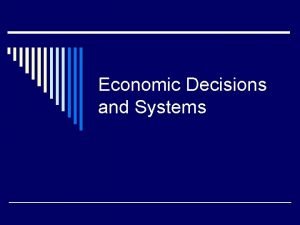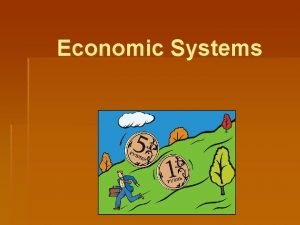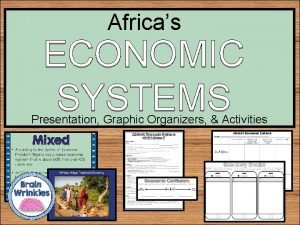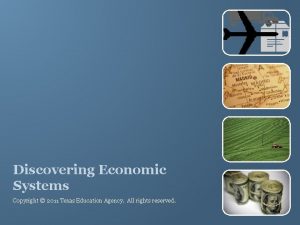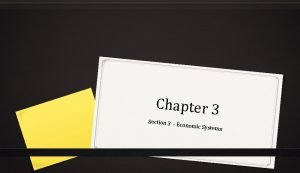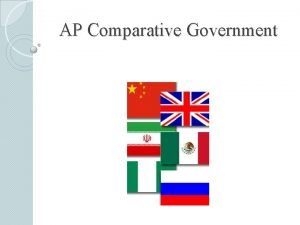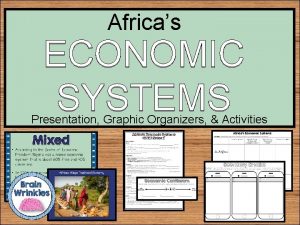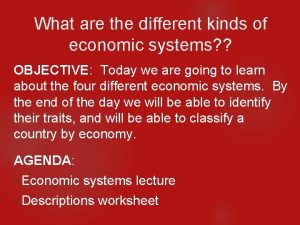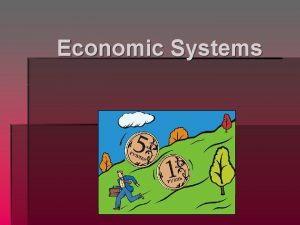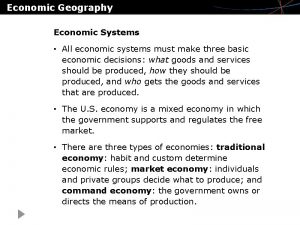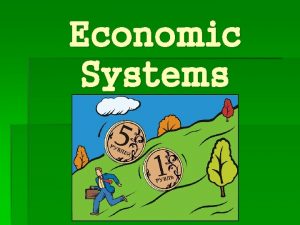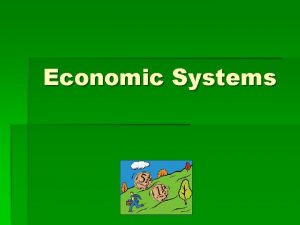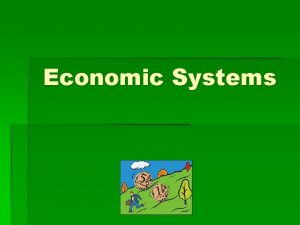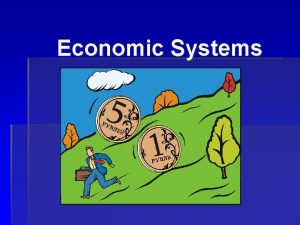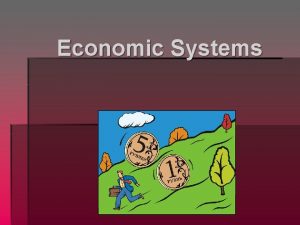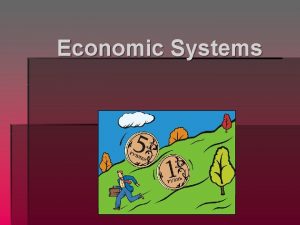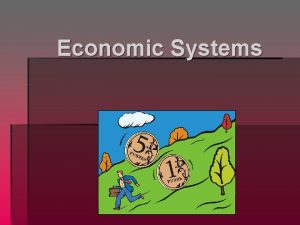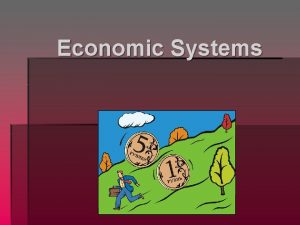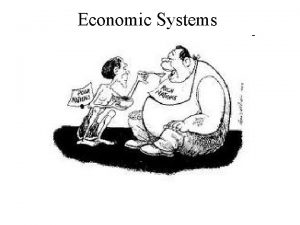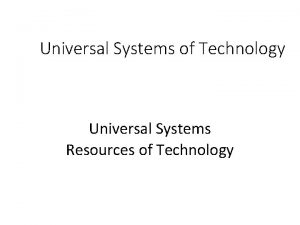Chapter 2 Universal Systems Universal Systems Economic Systems






















- Slides: 22

Chapter 2 Universal Systems

Universal Systems • Economic Systems • Political Systems • Educational Systems • Marriage and Family Systems • Social hierarchies and social interaction © 2011 Pearson Education, Inc. publishing as Prentice Hall 2

Economic ISMs • Socialism - You have two cows. Give one cow to your neighbor. • Communism - You have two cows. Give both cows to the government, and they may give you some of the milk. • Nazism - You have two cows. The government shoots you and takes both of the cows. • Anarchism - You have two cows. Keep both of the cows and shoot the government agent and steal another cow. • Capitalism - You have two cows. Sell one cow and buy a bull. © 2011 Pearson Education, Inc. publishing as Prentice Hall 3

HDI Country • • • • Rank U. S. Australia Canada China France Germany India Japan Mexico Netherlands New Zealand Singapore South Korea United Arab Emirates United Kingdom 12 03 04 81 10 22 128 08 52 09 19 25 26 39 16 © 2011 Pearson Education, Inc. publishing as Prentice Hall 4

Economic Systems • U. S. - capitalistic with socialistic overtones; free market with government regulations • United Kingdom - based on capitalism; since the 1980 s some sectors have been privatized; less regulation of industry has been encouraged • Mexico – capitalistic with social controls • Japan - capitalistic/free market • Canada - capitalistic with social controls in health care and retirement © 2011 Pearson Education, Inc. publishing as Prentice Hall 5

Political Systems • U. S. - president elected by electoral college; states have numerous rights. • Canada – confederation with parliamentary system; prime minister and members of the House of Commons elected; country divided into provinces; each province controls its region. • China - China’s policies are determined by a 20 -member Politboro and a 7 -member standing committee. The Chinese Communist Party is the only legal political party. • United Kingdom - ruled by a constitutional monarchy with a parliament. The monarch is head of state, but elected officials govern through Parliament. © 2011 Pearson Education, Inc. publishing as Prentice Hall 6

Political Systems (cont. ) • France - The French Republic has 22 regions, divided into 96 departments. President is the head of state and serves a 7 -year term. Prime minister is appointed by the President from the majority party in the National Assembly. • Germany – president is elected by members of the federal and state legislatures for a maximum of two 5 year terms. Chancellor is head of government, elected by the lower house of Parliament, the Federal Assembly. • Japan - constitutional monarchy but emperor has no power. Prime minister, lower house, and upper house elected by the people. Prefectures (states) have governors elected by the people. © 2011 Pearson Education, Inc. publishing as Prentice Hall 7

Political Systems (concl. ) • Iran - Six religious leaders and six lay leaders make up Council of Guardians; council approves presidential candidates. • Mexico - federal government with president elected by those over 18; voting is obligatory. President may serve only one term, but senators and deputies may serve more than one term (terms cannot be consecutive). Federal government controls some industries and education. • United Arab Emirates – federation of seven emirates • South Korea – most members of government are elected. State council includes the president, prime minister, and 15 -30 ministry heads. © 2011 Pearson Education, Inc. publishing as Prentice Hall 8

World Economics • • • Foreign competition Increased productivity World competition for positions Quality versus price Supernationalism Subnationalism © 2011 Pearson Education, Inc. publishing as Prentice Hall 9

Formal and Informal Education • Formal education - a formalized educational structure; education acquired in school • Informal education - no formal educational infrastructure © 2011 Pearson Education, Inc. publishing as Prentice Hall 10

Education in the U. S. • Learning concepts emphasized • Students taught to think for themselves • Reasoning and developing intellectual abilities © 2011 Pearson Education, Inc. publishing as Prentice Hall 11

Education in the U. S. Anybody can get into college in the United States. Malaysians, remarking on the easy accessibility of American colleges and universities, compared U. S. schools unfavorably to that of the British who once ruled Malaysia and provided the model for their educational system. However, the Malaysians observed, “You Americans put men on the moon, so there must be something right about your system. ” © 2011 Pearson Education, Inc. publishing as Prentice Hall 12

Education in Japan • National curriculum set up by the Ministry of Education. • Lessons are compulsory; core subjects are Japanese, Math, and English. • Teaching is considered a high status profession. Teachers must continue their professional involvement, be moral citizens, and act as role models to students. • Schools differentiate by ability. High expectations for students. • Parental involvement is very strong. © 2011 Pearson Education, Inc. publishing as Prentice Hall 13

Social Stratification Ranking of people in a society into higher and lower positions by other members of society, resulting in a hierarchy of respect and prestige. On what basis do we rank people? • • • authority power property ownership income lifestyle occupation • educational background • altruistic activity • kinship connections • ties with volunteer associations © 2011 Pearson Education, Inc. publishing as Prentice Hall 14

Occupational Rankings US Japan Supreme Court justices Physicians State Governors Prefectural governors University professors Local judges President’s Cabinet Diplomats Mayors of large cities University professors Scientists Congressional leaders Bankers Officers in large firms Government section heads Doctors Architects Owners of businesses Labor union leaders Newspaper reporters © 2011 Pearson Education, Inc. publishing as Prentice Hall 15

Family Systems • Nuclear family (father, mother, children) • Extended family (grandparents, uncles, aunts, cousins) © 2011 Pearson Education, Inc. publishing as Prentice Hall 16

Common Family Systems • Polygyny (1 man, many wives) Arab countries/Islamic believers • Polandry (1 woman, many husbands) Polynesian nations • Monogamy (1 husband wife) North and South America, Europe • Serial Monogamy (people remarry after divorce or death of spouse) U. S. © 2011 Pearson Education, Inc. publishing as Prentice Hall 17

Social Hierarchies/ Interaction • Social reciprocity - the way formal and informal communications are handled. – Involves • independent social reciprocity (avoids commitment); • symmetrical-obligatory social reciprocity (people have an equal obligation); • complementary-obligatory social reciprocity (people are forever indebted to others) • Group membership has two extremes – people can belong to many groups or very few groups; – people in the middle try to balance group affiliation and personal freedom © 2011 Pearson Education, Inc. publishing as Prentice Hall 18

Social Hierarchies/ Interaction • Intermediaries - people who act as gobetweens with other people • Formality - the degree of preciseness, regularity, or conformity expected within the society • Property – private (U. S. ) – utilitarian (Mexico) – community (Native American) © 2011 Pearson Education, Inc. publishing as Prentice Hall 19

Hierarchial Divisions • • • Ethnic groups Social classes Castes Tribes Gender © 2011 Pearson Education, Inc. publishing as Prentice Hall 20

Unequal Treatment of Men and Women in the World • Human Development Index (HDI) measures purchasing power, health, and education for the whole population and for women • Iceland, Norway, and Australia are 1, 2, and 3 respectively on overall HDI and 1, 3, and 2 on gender’s GDI. • U. S. is ranked 12 overall and 16 on gender © 2011 Pearson Education, Inc. publishing as Prentice Hall 21

© 2011 Pearson Education, Inc. publishing as Prentice Hall 22
 Chapter 1 lesson 2 our economic choices worksheet answers
Chapter 1 lesson 2 our economic choices worksheet answers Economic growth vs economic development
Economic growth vs economic development What is economic growth and development
What is economic growth and development Chapter 2 economic systems and decision making answer key
Chapter 2 economic systems and decision making answer key Chapter 2 economic systems answer key
Chapter 2 economic systems answer key Chapter 2 economic systems and decision making
Chapter 2 economic systems and decision making Chapter 2 economic systems and decision making
Chapter 2 economic systems and decision making Chapter 1 economic decisions and systems answer key
Chapter 1 economic decisions and systems answer key Chapter 2 economic resources and systems
Chapter 2 economic resources and systems Being resourceful meaning
Being resourceful meaning What is the purpose of an economic system
What is the purpose of an economic system Command economy examples
Command economy examples How many economic systems are there
How many economic systems are there Who or what decides what consumers get in each cartoon?
Who or what decides what consumers get in each cartoon? Lesson 3 the role of government in economic systems
Lesson 3 the role of government in economic systems Africa's economic systems cloze notes 2
Africa's economic systems cloze notes 2 Economic systems
Economic systems Topic 2 free enterprise and other economic systems
Topic 2 free enterprise and other economic systems Discovering economic systems comparative worksheet answers
Discovering economic systems comparative worksheet answers The three economic systems
The three economic systems Economic systems
Economic systems Africa's economic systems cloze notes 1
Africa's economic systems cloze notes 1 Advantages of mixed economy
Advantages of mixed economy







